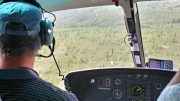While Nunavut, Canada’s third and easternmost Arctic territory, may mean “our land” in the Inuktitut language, Nunavut’s Inuit Premier Paul Okalik wants to make the words come completely true by having his government assume full control over the territory’s natural resources and lose its colonial status towards the Canadian government.
Brian Mulroney’s federal government conceived the idea of splitting off Nunavut from the Northwest Territories in the 1980s, and Nunavut officially came to life in 1999 under the framework of the Nunavut Land Claims Agreement.
Today, the vast territory is home to only 29,500 residents, of whom eighty-five per cent are Inuit. The Nunavut government is already using its limited autonomy to promote the Inuktitut language and culture by adopting language laws similar to those in Quebec, and is in favour of race-based hiring quotas for the territory’s government and private-sector jobs. (Forty-six per cent of territorial government employees are now Inuit, and the government is the territory’s largest employer.)
Still, the territory’s lack of basic infrastructure and housing remain critical issues for the Nunavut government. There are no fixed rail or road links to the rest of Canada, and no deep-water ports, despite Nunavut having the largest coastline in the country.
Speaking at an Empire Club luncheon in Toronto in mid-May, Okalik described his “Nunavut Dream” as the latest chapter in Canada’s history of opening up remote parts of the country to industrial development and settlement.
As a step to achieving this dream, Prime Minister Paul Martin and the three territorial premiers launched a “Northern Strategy” in December to promote northern development.
While the long-term value of any promise made by a Paul Martin-led government is questionable, the feds did commit to reaching an agreement to devolve its authority over Nunavut’s natural resources by the end of 2008. This process is complete in the Yukon and is nearing the end in the Northwest Territories.
On a pragmatic level, once devolution is completed, Nunavut officials will be able to deal directly with potential investors in the natural resources sector.
“Arrangements such as these are crucial if entire regions of this country are not to be treated as requiring welfare, while the riches of local resources flow to federal coffers,” said Okalik.
Like many in our industry, we see Nunavut as being on the cusp of relatively rapid economic development. To that end, now is a perfect time for the Nunavut and federal governments to make certain that Nunavut has the economic tools needed to ensure a measure of self-sufficiency.
Okalik wisely recognizes that to encourage investment and job creation in Nunavut, private industry must have an expanded role in the territory.
With that in mind, he has instructed Economic Development and Transportation Minister David Simailak to undertake a year-long effort to make the territory more business-friendly.
The ministry has set up a “Barriers to Business” working group to cut red tape and improve the current business climate, and is inviting input from the business community.
Most of Nunavut’s business regulations are inherited from the Northwest Territories, and Okalik has described a “growing sense among Nunavummiut that this regulatory system no longer serves us well — it is outdated and does not reflect our own distinctive economy.”
Okalik welcomes mining as one of the pillars of Nunavut’s economic future, along with the fisheries, oil and gas, tourism and cultural exports.
While there has been no producing, commercial mine in Nunavut since the closure in 2002 of Breakwater Resources’ Nanisivik zinc mine on northern Baffin Island, as many as four new mines could open in the territory before the end of the decade, beginning next year with Tahera’s Jericho diamond mine in western Nunavut, north of Yellowknife, N.W.T.
Others advancing to that point include: Wolfden Resources’ High Lake-Ulu polymetallic project in western Nunavut’s Coronation Gulf district; Hope Bay Gold’s gold project east of Bathurst Inlet; Cumberland Resources’ gold project north of Chesterfield Inlet; Baffinland Resources’ iron ore deposit on Baffin Island; and Starfield Resources’ Ferguson Lake massive-sulphide project, also near Chesterfield Inlet.
And, of course, throughout the territory, several dozen major diamond exploration programs are ongoing, and are due to be stepped up during the summer months.
Nunavut saw more than $150 million spent on mineral exploration in 2004, and prospecting permits were issued for more than 260,000 sq. km. Related construction and service activity have also greatly benefited northern communities.
“All of this represents a re-awakening of Canadian and international interest in the riches of the North, but this time Northerners will be partners in development,” said Okalik.
At the “mossroots” exploration level, the Nunavut government recently announced an increase in funding for the territory’s prospectors who work under the Nunavut Prospectors Program. The government has increased to $8,000 from $5,000 the maximum funding a prospector may receive annually, and has extended the program to 2010.
More than four hundred people from across Nunavut, or more than one per cent of the population, have now graduated from prospecting training courses delivered by the Economic Development and Transportation ministry. The courses are now in their sixth year and are taught in eight communities.
The program appears to be a success, with several Nunavut prospectors having discovered mineral deposits and inked option agreements with companies.
The harsh realities of carrying out Arctic mineral exploration and development are obvious, but there are some benefits, too.
Of special interest to the mining industry is Nunavut’s lack of a capital tax, while corporate and personal income taxes remain among the lowest in the country.
Unlike other jurisdictions in western Canada, Nunavut’s land claims are more or less settled, thereby providing certainty of land ownership, though parks and other protected areas now cover almost fourteen per cent of the territory’s landmass.
“What we are asking now is for others to do their part,” said Okalik. “For the federal government to remove the colonial reins that are holding us back and to do for the North what was done for the rest of the country.”
In short: we demand Ottawa increase our funding so that we can be more independent. Why, Okalik is sounding more like a provincial premier every day.



Be the first to comment on "Editorial: Nunavut wants it all, now"